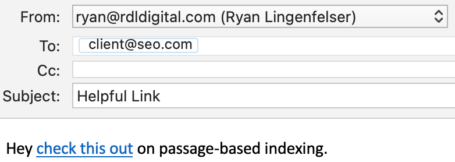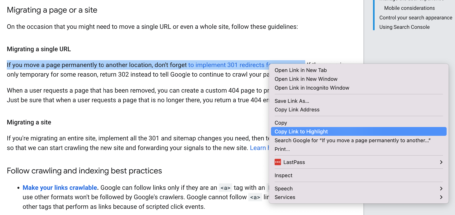When sending a link to a colleague or friend, we may use the plain URL or include it with anchor text like ‘check this out.’

If there’s a section you want them to focus on for that page, you’d mention that it’s under a header or maybe a few paragraphs in so they could find it.
However, we now be more specific with deep links:
- When visiting a page in Google Chrome, you can select text then right-click for ‘Copy Link to Highlight.’ You’ll notice Google uses this in search results when clicking the link for a featured snippet. Google Docs Editors allow the same thing by linking to a tab or slide by default.
- If the page has jump or anchor links (you’ll see a hash in the URL) through a table of contents, you can also link more specifically. Just share the link from the table of contents that when clicked will scroll you to that section. Below the meta description in search results, you’ll often see sitelinks or small blue links to sections on that page if they have a table of contents.



Beyond making information easier to find, this affects SEO since deep links provide better context.
At the end of 2020, Google said that it made advancements in ranking passages. Therefore, Google may be able to interpret these links, leading to better chances of ranking your content in featured snippets. Even if not quite there yet, this seems like a sensible investment since it helps users too!
Finally, deep links reconcile multiple goals for a single page. This is better for SEO because it means fewer pages versus more, which consolidates authority, though this advantage may be offset through relevancy.
Therefore, you should use these methods on your company pages too and not just for sharing links with others!
